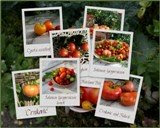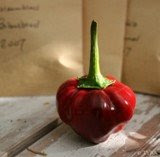ABC wednesday 'E' is for Elder.

Elderberries Sambucus nigra in my beer bucket.
Elderberry and Apple Crumble
350g (12 oz) elderberries (common elder)
450g (1lb) apples
110g (4oz) sugar
225g (8oz) flour
110g (4oz) light brown sugar
110g (4oz) butter
A pinch each of bicarbonate of soda.
*A variant is to add ginger, cardamom or cinnamon to the crumble
Rinse the elderberries and then pull off their stalks. Core, peel (optional) and chop the apples. Mix apples together with the elderberries and sugar and put into an ovenproof dish. Rub the butter into the sieved flour; add the sugar, the bicarbonate of soda and the spice*. Press down lightly over the fruit and cook the crumble in the oven at 380F, 200°C about thirty five to forty minutes.
...
Have anyone tried to dry the elderberries?
If yes please tell us how you did it and the result. It would be nice to have them during the winter as well. Elder is used in Phytotherapy - The flowers may be used to make an herbal tea, which is believed as a remedy for colds and fever.
Stem bark, leaves, flowers, and berries, root extracts are used to treat bronchitis, cough, upper respiratory cold infections as well as fever.

The Multifaceted Elder..
Which Elder lives near you? Do you have it in your garden?
Do you use the Elder as a medicinal plant?
As food?
Or perhaps made some delicious wine?
I know
Yolanda at Bliss make a delicious Elderberry Champagne.
...
The whereabout of Elder.
It is fascinating to read about the Elders species groups and their whereabouts around the globe this is what wikipedia writes about Elder.
"The common elder complex is variously treated as a single species Sambucus nigra found in the warmer parts of Europe and North America with several regional varieties or subspecies, or else as a group of several similar species. The flowers are in flat corymbs, and the berries are black to glaucous blue; they are larger shrubs, reaching 5–8 m tall, occasionally small trees up to 15 m tall and with a stem diameter of up to 30–60 cm.
Sambucus australis (Southern Elder; temperate eastern South America)
Sambucus canadensis (American Elder; eastern North America; with blue-black berries)
Sambucus cerulea ( S. glauca; Blueberry Elder; western North America; with blue berries)
Sambucus javanica (Chinese Elder; southeastern Asia)
Sambucus mexicana (Mexican Elder; Mexico and Central America; with blue-black berries)
Sambucus nigra (Elder or Black Elder; Europe and western Asia; with black berries)
Sambucus palmensis (Canary Islands Elder; Canary Islands; with black berries)
Sambucus peruviana (Peruvian Elder; northwest South America; with black berries)
Sambucus simpsonii (Florida Elder; southeastern United States; with blue-black berries)
Sambucus peruviana (Andean Elder; northern South America; with blue-black berries)
Sambucus velutina (Velvet Elder; southwestern North America; with blue-black berries)
The Blackberry Elder Sambucus melanocarpa of western North America is intermediate between the preceding and next groups. The flowers are in rounded panicles, but the berries are black; it is a small shrub, rarely exceeding 3–4 m tall. Some botanists include it in the red-berried elder group.
The red-berried elder complex is variously treated as a single species Sambucus racemosa found throughout the colder parts of the Northern Hemisphere with several regional varieties or subspecies, or else as a group of several similar species. The flowers are in rounded panicles, and the berries are bright red; they are smaller shrubs, rarely exceeding 3–4 m tall.
Sambucus callicarpa (Pacific Coast Red Elder; west coast of North America)
Sambucus chinensis (Chinese Red Elder; eastern Asia, in mountains)
Sambucus latipinna (Korean Red Elder; Korea, southeast Siberia)
Sambucus microbotrys (Mountain Red Elder; southwest North America, in mountains)
Sambucus pubens (American Red Elder; northern North America)
Sambucus racemosa (European Red Elder; northern Europe, northwest Asia)
Sambucus sieboldiana (Japanese Red Elder; Japan and Korea)
Sambucus tigranii (Caucasus Red Elder; southwest Asia, in mountains)
Sambucus williamsii (North China Red Elder; northeast Asia)
The Australian elder group comprises two species from Australasia. The flowers are in rounded panicles, and the berries white or yellow; they are shrubs growing to 3 m high.
Sambucus australasica (Yellow Elder; New Guinea, eastern Australia)
Sambucus gaudichaudiana (Australian Elder or White Elder; shady areas of south eastern Australia)
The dwarf elders are, by contrast to the other species, herbaceous plants, producing new stems each year from a perennial root system; they grow to 1.5–2 m tall, each stem terminating in a large flat umbel which matures into a dense cluster of glossy berries.
Sambucus adnata (Asian Dwarf Elder; Himalaya and eastern Asia; berries red)
Sambucus ebulus (European Dwarf Elder; central and southern Europe, northwest Africa and southwest Asia; berries black)"
wikipedia Elderberry
Don't be a stranger my friend, do write something!
TYRA



 and the gardener is so busy...full of activity.
and the gardener is so busy...full of activity.













 Two Dahlias in full bloom in my potager, they are so very different and the light on the flowers is very different too. I think it is very pretty when the light is almost shining through in the Dahlia in latter picture.
Two Dahlias in full bloom in my potager, they are so very different and the light on the flowers is very different too. I think it is very pretty when the light is almost shining through in the Dahlia in latter picture.




































